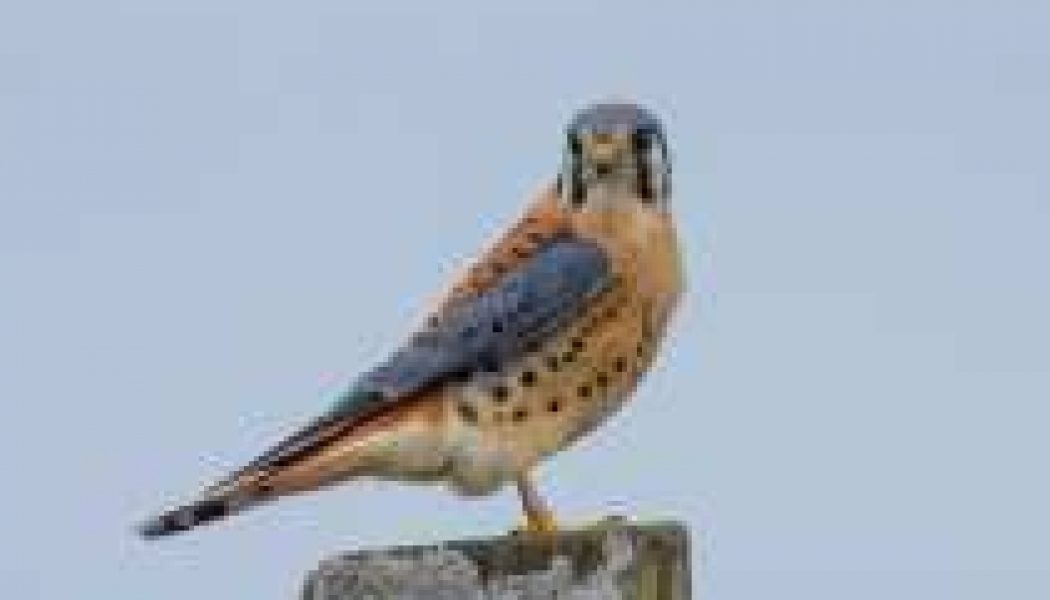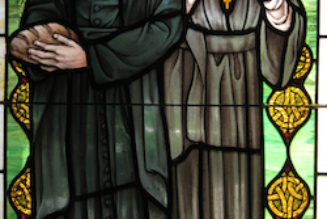Here are all the possible outcomes of the bird personality quiz!
 AMERICAN KESTREL
AMERICAN KESTREL
Quick and feisty, acrobatic and graceful, you are single-minded and determined. You enjoy traveling, going to baseball games, and eating on the go. You’re not interested in home maintenance—you’re exceptionally tolerant of messy living quarters.
About American Kestrels: This tiny, colorful falcon specializes on insects and small mammals and birds. It can see in the ultraviolet range, which helps it follow urine trails of some prey. Some kestrels have started visiting ballparks, where they can catch insects illuminated by the floodlights. One, nicknamed Kirby, became a popular fixture at Minnesota Twins games in 2010. Kestrels nest in natural cavities, woodpecker nest holes, and bird boxes. With no way to dispose of the chicks’ droppings, they simply squirt them on the walls; meanwhile, bits of uneaten prey start collecting on the nest floor. Despite the messy build-up, kestrels that are successful raising young in a cavity tend to return to the same one the next year. Learn more about American Kestrels on allaboutbirds.org – American Kestrels. Photo Credit: © Laura Erickson, MN, May 2013
 AMERICAN ROBIN
AMERICAN ROBIN
Some people think you have a “split personality” because at times you are gregarious and extroverted, while other times you can’t stand to be anywhere near anyone except your family. You’re a talented singer with excellent communication skills, and you love to wander.
About American Robins: The American Robin, state bird of Connecticut, Michigan, and Wisconsin, is beloved for its beautiful song and homey ways, nesting in our backyards. But it is less popular when it gorges on people’s fruit trees and wages territorial battles with its own reflection at our windows. Robins may begin singing in the middle of the night, singing most urgently before dawn. When they have enough light to see earthworms, they quiet down to focus on breakfast for a while. A pair of robins may stick together for the entire summer, raising two, three, or even four broods of young. After they’ve stopped nesting for the season, territorial pairs join robin flocks and spend the winter wandering here and there, feeding on fruits. They grow territorial the following spring. Some robins return to the same nesting area year after year, but not predictably so. Learn more about robins on allaboutbirds.org – American Robins. Photo Credit: © Laura Erickson, WI June 2015
 BALD EAGLE
BALD EAGLE
You’re strong and powerful, yet extremely gentle with babies. You are a loner who is loyal to your family. You can stick with a project for years. You can wander long distances searching for the best fishing spots.
About Bald Eagles: The Bald Eagle was chosen as the national emblem of the United States in 1792, and has been a spiritual symbol for Native Americans for far longer. We treasure it for its magnificent beauty and strength. A pair of eagles builds a huge stick nest in a large tree, often a white pine, and returns to the nest year after year, repairing and strengthening it as needed. Eagles eat fish, seabirds, and a wide variety of other prey, including road-killed animals. They often grab and fly off with fish caught by Osprey. Learn more about Bald Eagles on allaboutbirds.org – Bald Eagles. Photo Credit: © Laura Erickson, OH, May 2012
 BLUE JAY
BLUE JAY
You combine brains, beauty, and loyalty to family and friends. Quick to anger when you feel threatened, you also have a sense of humor. Adaptable and unpredictable, you enjoy a wide variety of foods and communicate well both vocally and with body language.
About Blue Jays: The strikingly attractive Blue Jay, the provincial bird of Prince Edward Island, belongs to the same family as crows and ravens. People seem to either love it for its beauty and intelligence or hate it for raiding the nests of other birds to feed its own young. Blue Jays are extremely sociable, with lots of different calls used in specific situations with their mate, family, and other jays. They also communicate with their crest, which they raise when agitated or lower when in intimate family situations or when feeding peaceably in a flock. Blue Jay migration is one of the mysteries of the bird world: people haven’t teased out all the factors that make individuals decide to migrate one year and not the next. Just one species is officially named the Blue Jay, but several other jays are blue, including Steller’s Jay, Mexican Jay, Pinyon Jay, and three species of scrub-jays. Learn more about Blue Jays on allaboutbirds.org – Blue Jays. Photo Credit: © Laura Erickson, MN, October 2014
 CANADA GOOSE
CANADA GOOSE
Family ties and friendships are important to you. You’re chatty and sociable, hardy and adaptable, but very traditional. You do things the way your parents did rather than trying new approaches. A natural leader, you’re not bossy and let others take the lead, too.
About Canada Geese: The Canada Goose is an extremely clannish species. Young learn their migration route from their parents, and during migration and winter often band together with family members and acquaintances from previous years. Canada Geese are very hardy and can winter in the north where they can find open water. This is one of the only North American birds that can digest grass, so expansive lawns are big invitations for them. Any geese living in Canada could be called Canadian geese, but the Canada Goose lives in the United States, too. Since the 1970s, increasing numbers of them have adapted to urban life. Learn more about Canada Geese on allaboutbirds.org – Canada Geese. Photo Credit: © Laura Erickson, NY, March 2009
 CHICKADEE (Black-capped Chickadee pictured here)
CHICKADEE (Black-capped Chickadee pictured here)
You are curious, smart, talkative, and bold. You also have a lot of energy, like to try new things, but like to stay close to home. You are a creative person. You stick with your neighbors and readily welcome others, even strangers, into your social circle.
About Chickadees: A bird almost universally considered “cute” thanks to its oversized round head, tiny body, and curiosity about everything, including humans. Chickadees are active, acrobatic, curious, social birds that live in flocks, often associating with woodpeckers, nuthatches, warblers, vireos, and other small woodland species. Seven species of chickadees can be found in North America: the Black-capped Chickadee, Carolina Chickadee, Mountain Chickadee, Chestnut-backed Chickadee, Boreal Chickadee, Mexican Chickadee, and Gray-headed Chickadee. The Black-capped Chickadee is the state bird of Maine and Massachusetts, and the provincial bird of New Brunswick. Learn more about chickadees on allaboutbirds.org – chickadees. Photo Credit: Black-capped Chickadee © Laura Erickson, MN, October 2014
 CROW (Fish Crow pictured here)
CROW (Fish Crow pictured here)
You’re as smart as they come, and you know it! Hardy and adaptable, you’re extremely loyal and devoted to your family, friends, and neighbors, but are suspicious of strangers. You’re curious and an excellent problem solver, while also knowing how to have fun!
About Crows: Crows, close relatives of ravens, are considered one of the most intelligent and adaptable birds in the world. Very social, they can form flocks in the thousands. Inquisitive and sometimes mischievous, they are good learners and problem-solvers, often raiding garbage cans and picking over discarded food containers. They’re also aggressive against perceived threats and often chase away larger birds such as hawks, owls, and herons. In North America, there are three species of crows (American, Northwestern, and Fish crows) and two ravens (Common and Chihuahuan raven). Learn more about crows on allaboutbirds.org – crows. Photo Credit: American Crow © Laura Erickson, DE, May 2013
 GOLDFINCH (American Goldfinch pictured here)
GOLDFINCH (American Goldfinch pictured here)
Popular and attractive, you’re extremely sociable and talkative, and a fine singer. You’re resourceful and inventive, but rather unpredictable and flighty, keeping people guessing about your plans and whereabouts. You pretty much stick to a vegetarian diet.
About Goldfinches: The state bird of New Jersey, Iowa, and Washington, the beloved American Goldfinch is found in backyards as well as open areas. It feeds on weed seeds (especially thistle and milkweed) and, at feeders, on sunflower and nyjer, and seems to eat few or no insects. Goldfinches nest later than most birds, not starting until milkweed, thistle, and other plants start going to seed; they use these fibrous seeds both for nesting materials and for food for themselves and their nestlings. American Goldfinches are nomadic in winter, usually most abundant where natural food is also abundant. This makes it difficult to predict where they will be common from one winter to the next. Learn more about goldfinches on allaboutbirds.org – goldfinches. Photo Credit: American Goldfinch © Laura Erickson, MN, June 2015
 GREAT BLUE HERON
GREAT BLUE HERON
You are a master of patience with an almost preternatural inner stillness. After you work out a solution to a problem, you use it over and over. A loner at heart, for you there is a time and a place for everything, including family matters. You can easily pull all-nighters.
About Great Blue Herons: The elegant and stately Great Blue Heron is a master at fishing, and some individuals use those same skills of stealth and patience to strike at other prey, such as chipmunks and small waterbirds. For its huge size, the Great Blue Heron doesn’t weigh much—only about 6 pounds. It has a powerful, heavy bill and neck muscles, but its slow gait and flight mean it can get by without very heavy muscles anywhere else. It needs to be large to wade in fairly deep water and to capture and swallow large fish, so it manages to be both large and yet surprisingly scrawny under the plumage. Adults are very devoted parents, and often nest in large colonies, but after the nesting season spend the rest of the year pretty much alone, keeping their distance as much as possible even in the richest fishing areas. Learn more about Great Blue Herons on allaboutbirds.org – Great Blue Herons. Photo Credit: © Laura Erickson, TX Feb 2013
 GREAT HORNED OWL
GREAT HORNED OWL
Soft-spoken and retreating, you often appear to be sleeping on the job, but are extremely observant and powerfully effective when you act. A loner who sticks close to home, you are tender and gentle with your family and keep in close contact with your partner.
About Great Horned Owls: This large, regal owl, the provincial bird of Alberta, is found over most of North America and a lot of South America. It’s usually non-migratory. Pairs work together to feed their chicks, and remain near the nesting territory after the young move on. They tend to be fairly solitary, but pairs often remain in vocal contact. Powerful and versatile, they take a wide variety of prey, from insects and small rodents to animals weighing more than they do, such as Great Blue Herons, porcupines, and skunks. Great Horned Owls usually hunt by night, but can hunt in daylight, especially as their young need more food than they can get just by night. When we see them roosting in the daytime, they often have their eyes mostly closed, but are still alert and watching us right back. When crows, jays, robins, and some other birds notice one, they try to drive it off. People most often see owls when they hear the blood-curdling calls of crows “mobbing” them. Learn more about Great Horned Owls on allaboutbirds.org – Great Horned Owls. Photo Credit: © Laura Erickson, MN, March 2012
 HUMMINGBIRD (Ruby-throated Hummingbird pictured here)
HUMMINGBIRD (Ruby-throated Hummingbird pictured here)
You are extremely energetic and athletic, independent, and strong. You’re not very good at sharing or playing with a team, but you accomplish plenty on your own. You can’t help it—you love sweets! You notice every little thing going on around you.
About Hummingbirds: Hummingbirds include the tiniest of all birds, and are extremely territorial and independent. Females build the nest and raise the young without any help from males. Hummingbirds chase off just about any birds from their territories: they’ve even been observed chasing Bald Eagles! They feed on a wide variety of insects, flower nectar, and sugar water at hummingbird feeders. They’re powerful fliers, some species able to beat their wings more than 50 beats per second. Every spring and fall, Ruby-throated Hummingbirds fly non-stop over the Gulf of Mexico en route to their nesting range in eastern North America. Over 300 species of hummingbirds can be found in the Americas, from Alaska to Tierra del Fuego. The Ruby-throated Hummingbird is the only hummingbird that nests in the Eastern United States and Canada. Rufous Hummingbird nests in the Rocky Mountains, and Anna’s Hummingbird along the West Coast. Learn more about hummingbirds on allaboutbirds.org – Hummingbirds. Photo Credit: Ruby-throated Hummingbird © Laura Erickson, MN, May 2016
 MAGPIE (Yellow-billed Magpie pictured here)
MAGPIE (Yellow-billed Magpie pictured here)
Extremely intelligent, sociable, and creative, you express yourself with versatility. You collect interesting things and plan for the future. Family and neighborhood are important to you. You love home improvement projects; “bigger is better” seems to be your rule.
About Magpies: This member of the crow and raven family has an exceptionally wide range of calls and whistles. A pair of magpies may take more than a month to build their domed nest, which will be about 30 inches high and 20 inches wide. Magpies eat a wide assortment of food, from seeds and berries to carrion. When food is abundant, magpies store food items, including live ticks that they pull off the backs of cattle and other large mammals. Two species of magpies are found in North America, the wide-ranging Black-billed Magpie and the Yellow-billed Magpie, which is found only in California. Learn more about magpies on allaboutbirds.org – magpies. Photo Credit: Yellow-billed Magpie © Laura Erickson, CA, December 2013
 MALLARD
MALLARD
You’re sociable and fun, and get along well with others, never joining cliques but happy to include just about anyone in your social circles. You’re adaptable and enjoy a wide range of physical activities, especially swimming as long as you don’t have to dive.
About Mallards: Mallards, found on every continent except Antarctica, were one of the first domesticated birds. (White farm ducks, or “Pekin Ducks,” are Mallards.) They eat a wide variety of foods and can survive even extremely severe winters where open water and food are available. They spend most of the year in flocks that may include other species of ducks. After their family responsibilities are over, males join other males in flocks, which the females and grown ducklings join as soon as the young are independent. Learn more about Mallards on allaboutbirds.org – Mallards. Photo Credit: © Laura Erickson, CA, January 2016
 MOURNING DOVE
MOURNING DOVE
Devoted to family and friends, quiet and peaceable, you gravitate to others, enjoying large meals in convivial company. You seem still and quiet one moment, powerful and athletic the next. You are sometimes careless with what seem like minor details.
About Mourning Doves: This extremely popular gamebird is also a familiar backyard feeder bird. The long, mournful song, called the “Perch Coo,” is given mostly by unattached males seeking a mate. The dove’s wings are loud on takeoff, which may sometimes help warn others of approaching danger. Mourning Doves are devoted mates, feeding their two chicks (“squabs”) a substance called “pigeon milk” which both parents produce in their crop. Learn more about Mourning Doves on allaboutbirds.org – Mourning Doves. Photo Credit: © Laura Erickson, MN, July 2016
 NORTHERN CARDINAL
NORTHERN CARDINAL
You’re musically talented and may sing pretty much all day long when you’re inspired. You’re steady and reliable, and people love you for sharing your beautiful gifts. You’re fairly low-key about most things, but sometimes want to protect your personal space from others.
About Northern Cardinals: The Northern Cardinal’s voice and plumage make it so popular that it’s the state bird of seven states, more than any other bird (Illinois, Indiana, Kentucky, North Carolina, Ohio, Virginia, and West Virginia). Cardinals often associate with other cardinals during fall and winter, but are very territorial during the breeding season, sometimes even trying to drive away their own reflection if they notice it in a window or car mirror. They feed on a wide assortment of insects and some fruits and seeds, often visiting bird feeders. Non-migratory, they can survive extremely cold winters if they have enough food; bird feeders help their survival, especially in northern states. Learn more about Northern Cardinals on allaboutbirds.org – Northern Cardinals. Photo Credit: Northern Cardinal © Laura Erickson, MN, May 2016
 NORTHERN MOCKINGBIRD
NORTHERN MOCKINGBIRD
You love imitating everything you hear, sometimes to the point of annoying those around you, but your extraordinary talent makes you very popular anyway. You don’t get set in your ways but are a lifelong learner. You are protective of home and family.
About Northern Mockingbirds: The versatility of the Northern Mockingbird’s song repertoire (males may sing over 200 different songs) endeared them to Thomas Jefferson, who boasted that Great Britain had nothing to compare. The more songs a male sings, the more easily he attracts a mate. Mockingbirds may sing different songs in fall than in spring. Their diet includes fruits and insects. They dive-bomb cats, snakes, people, and any other perceived enemies near their nests. The Northern Mockingbird is the state bird of Arkansas, Florida, Mississippi, Tennessee, and Texas. Learn more about mockingbirds on allaboutbirds.org – Northern Mockingbirds. Photo Credit: © Laura Erickson, GA, October 2014
 PEREGRINE FALCON
PEREGRINE FALCON
Powerful and athletic, you are devoted to family but keep your distance even from them most of the time. Your single-mindedness and focus make you very successful and respected, but you’re quick to cut your losses when a plan doesn’t work out.
About Peregrine Falcons: Peregrine Falcons, which have been clocked using radar flying more than 200 mph in a dive, may be the fastest birds on the planet, though some swifts have been observed outpacing them to get away. Peregrine Falcons nest on cliffs and buildings, pairs returning to the nest each year, though if one doesn’t come back, the other readily accepts a new mate. Peregrines were almost wiped out due to the pesticide DDT, but protections by the Endangered Species Act and prohibiting DDT use in the United States helped them make a dramatic comeback. Learn more about Peregrine Falcons on allaboutbirds.org – Peregrine Falcons. Photo Credit: © Laura Erickson, MN, June 2006
 RED-TAILED HAWK
RED-TAILED HAWK
You’re smart and curious, strong and determined. Your voice is so magnificent that you could make a living in Hollywood. You understand strategy, and sometimes work with a partner, but overall most of the time you are happy to be alone.
About Red-tailed Hawks: The thrilling cry of the Red-tailed Hawk is often heard on TV shows and movies to conjure wilderness or power, often in a scene showing a Bald Eagle. America’s most widespread raptor has a huge prey base, able to eat just about anything from insects and mice to jackrabbits and pheasants, including prey weighing almost twice as much as it does. Not as fast or maneuverable in flight as a falcon, the Red-tailed Hawk makes up for it with strength and stealth. Red-tailed Hawks are found in just about every habitat except dense forest. Learn more about Red-tailed Hawks on allaboutbirds.org – Red-tailed Hawks. Photo Credit: © Laura Erickson, MN, September 2011
 ROCK PIGEON
ROCK PIGEON
Extremely intelligent, sociable, and adaptable, you thrive in a great many situations. Your devotion to home is exceptional, as is your sense of direction. You prefer a vegetarian diet and seldom dine alone.
About Rock Pigeons: Pigeons, domesticated at least 5,000 years ago, and brought to America by early settlers in the 1600s, have been used by people both for food and sport. They can fly many hundreds of miles back to their nest and mate; this homing ability led to their use in pigeon races and also to carry messages. The U.S. Army Signal Corps’ racing pigeons saved lives and provided vital strategic information during World War I and II. B.F. Skinner, who did a great deal of research on pigeons, believed they were among the most intelligent animals in the world. Learn more about Rock Pigeons on allaboutbirds.org – Rock Pigeons. Photo Credit: © Laura Erickson, CA, September 2013
 RAVEN (Common Raven pictured here)
RAVEN (Common Raven pictured here)
Extremely intelligent and sociable, you love practical jokes and figuring out tricky situations. You’re devoted to family and friends, playful, acrobatic, and hardy. Even those who don’t like you can’t help but respect your many talents.
About Ravens: The bird often judged the most intelligent bird on the planet is the Yukon Territory’s symbolic bird. Ravens, closely related to crows, are acrobatic fliers, often doing rolls and somersaults in the air. One was seen flying upside down for more than a half-mile. Young ravens play games with sticks, repeatedly dropping them, then diving to catch them in midair. Even though sociable, raven pairs maintain a territory year-round and keep other ravens out. Many cultures revere ravens, or at least have created mythology around them, especially as tricksters or wise rulers. Learn more about ravens on allaboutbirds.org – ravens. Photo Credit: Common Raven © Laura Erickson, CA, September 2013
 SNOWY OWL
SNOWY OWL
You are strong and hardy, and people find your charisma irresistible. You’re unpredictable, keeping people guessing about where you might pop up next. You may travel far and wide, but prefer to stop in places that look like home.
About Snowy Owls: The Snowy Owl is among the most beloved and iconic birds in the world. The provincial bird of Quebec and Harry Potter’s beloved companion, it spends most of its life above the Arctic Circle, but many individuals wander south in winter, sometimes in dramatic “irruptions,” often appearing along coasts and lakeshores, or open fields somewhat resembling the tundra. Researchers are working hard to tease out the factors that lead to these irregular irruptions even as some individuals return to the same winter spots year after year. Capable of taking fairly large prey such as ptarmigans and geese, Snowy Owls spend most of their time taking hamster-sized lemmings whenever they’re available. When lemmings are abundant, Snowy Owls may produce and raise 11 chicks in a single brood, while when lemming populations are low, they may raise just 1-3 chicks. Learn more about Snowy Owls on allaboutbirds.org – Snowy Owls. Photo Credit: © Laura Erickson, MN, March 2012
 SCREECH-OWL (Eastern Screech-Owl pictured here)
SCREECH-OWL (Eastern Screech-Owl pictured here)
Steady and reliable, calm and focused, your quiet ways belie your single-minded focus. You stick close to home, shunning travel. You’re not much into building or home improvement projects, but appreciate the work of others.
About Screech-Owls: This pint-sized owl does not live up to its name: instead of screeching, Eastern Screech-Owls call with quiet trills and whinnies and Western Screech-Owls utter quiet whistled hoots. Screech-owls mate for life and may roost together. Birds seem to prefer a mate of the same age. Screech-owls roost and nest in natural cavities, woodpecker holes, nest boxes, and sometimes nooks and crannies on buildings. They feed on insects and small mammals and birds. Three species of screech-owls are found in North America, the Eastern, Western, and Whiskered screech-owls. Learn more about screech-owls on allaboutbirds.org – screech-owls. Photo Credit: Eastern Screech-Owl © Laura Erickson, MN, March 2012








